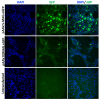Oligodendrocytes, the Forgotten Target of Gene Therapy
- PMID: 39682723
- PMCID: PMC11640421
- DOI: 10.3390/cells13231973
Oligodendrocytes, the Forgotten Target of Gene Therapy
Abstract
If the billions of oligodendrocytes (OLs) populating the central nervous system (CNS) of patients could express their feelings, they would undoubtedly tell gene therapists about their frustration with the other neural cell populations, neurons, microglia, or astrocytes, which have been the favorite targets of gene transfer experiments. This review questions why OLs have been left out of most gene therapy attempts. The first explanation is that the pathogenic role of OLs is still discussed in most CNS diseases. Another reason is that the so-called ubiquitous CAG, CBA, CBh, or CMV promoters-widely used in gene therapy studies-are unable or poorly able to activate the transcription of episomal transgene copies brought by adeno-associated virus (AAV) vectors in OLs. Accordingly, transgene expression in OLs has either not been found or not been evaluated in most gene therapy studies in rodents or non-human primates. The aims of the current review are to give OLs their rightful place among the neural cells that future gene therapy could target and to encourage researchers to test the effect of OL transduction in various CNS diseases.
Keywords: AAV; central nervous system; gene therapy; oligodendrocytes.
Conflict of interest statement
B.P. and Ö.G.Y. are co-inventors of the vectors equipped with MAG and synthetic MAG promoters cited in the review. B.P. is the owner of the Therapy Design Consulting company.
Figures

Similar articles
-
Glial promoter selectivity following AAV-delivery to the immature brain.PLoS One. 2013 Jun 14;8(6):e65646. doi: 10.1371/journal.pone.0065646. Print 2013. PLoS One. 2013. PMID: 23799030 Free PMC article.
-
Optimizing promoters for recombinant adeno-associated virus-mediated gene expression in the peripheral and central nervous system using self-complementary vectors.Hum Gene Ther. 2011 Sep;22(9):1143-53. doi: 10.1089/hum.2010.245. Epub 2011 Jun 1. Hum Gene Ther. 2011. PMID: 21476867 Free PMC article.
-
Selective and rapid uptake of adeno-associated virus type 2 in brain.Hum Gene Ther. 1998 May 20;9(8):1181-6. doi: 10.1089/hum.1998.9.8-1181. Hum Gene Ther. 1998. PMID: 9625257
-
Challenges in adeno-associated virus-based treatment of central nervous system diseases through systemic injection.Life Sci. 2021 Apr 1;270:119142. doi: 10.1016/j.lfs.2021.119142. Epub 2021 Jan 30. Life Sci. 2021. PMID: 33524419 Review.
-
Adeno-associated virus-based vectors in gene therapy.J Biomed Sci. 2000 Jul-Aug;7(4):279-91. doi: 10.1007/BF02253246. J Biomed Sci. 2000. PMID: 10895050 Review.
Cited by
-
Current trends in gene therapy to treat inherited disorders of the brain.Mol Ther. 2025 May 7;33(5):1988-2014. doi: 10.1016/j.ymthe.2025.03.057. Epub 2025 Apr 2. Mol Ther. 2025. PMID: 40181540 Review.
References
Publication types
MeSH terms
LinkOut - more resources
Full Text Sources
Medical

